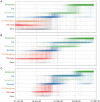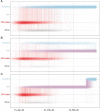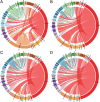This is a preprint.
Accommodating individual travel history, global mobility, and unsampled diversity in phylogeography: a SARS-CoV-2 case study
- PMID: 32596695
- PMCID: PMC7315996
- DOI: 10.1101/2020.06.22.165464
Accommodating individual travel history, global mobility, and unsampled diversity in phylogeography: a SARS-CoV-2 case study
Update in
-
Accommodating individual travel history and unsampled diversity in Bayesian phylogeographic inference of SARS-CoV-2.Nat Commun. 2020 Oct 9;11(1):5110. doi: 10.1038/s41467-020-18877-9. Nat Commun. 2020. PMID: 33037213 Free PMC article.
Abstract
Spatiotemporal bias in genome sequence sampling can severely confound phylogeographic inference based on discrete trait ancestral reconstruction. This has impeded our ability to accurately track the emergence and spread of SARS-CoV-2, which is the virus responsible for the COVID-19 pandemic. Despite the availability of staggering numbers of genomes on a global scale, evolutionary reconstructions of SARS-CoV-2 are hindered by the slow accumulation of sequence divergence over its relatively short transmission history. When confronted with these issues, incorporating additional contextual data may critically inform phylodynamic reconstructions. Here, we present a new approach to integrate individual travel history data in Bayesian phylogeographic inference and apply it to the early spread of SARS-CoV-2, while also including global air transportation data. We demonstrate that including travel history data for each SARS-CoV-2 genome yields more realistic reconstructions of virus spread, particularly when travelers from undersampled locations are included to mitigate sampling bias. We further explore the impact of sampling bias by incorporating unsampled sequences from undersampled locations in the analyses. Our reconstructions reinforce specific transmission hypotheses suggested by the inclusion of travel history data, but also suggest alternative routes of virus migration that are plausible within the epidemiological context but are not apparent with current sampling efforts. Although further research is needed to fully examine the performance of our new data integration approaches and to further improve them, they represent multiple new avenues for directly addressing the colossal issue of sample bias in phylogeographic inference.
Figures









References
-
- Deng X. et al. A Genomic Survey of SARS-CoV-2 Reveals Multiple Introductions into Northern California without a Predominant Lineage. medRxiv (2020).
-
- Landry M. L., Neher R. A., Ko A. I. & Grubaugh N. D. Coast-to-coast spread of SARS-CoV-2 in the United States revealed by genomic epidemiology. medRxiv (2020).
Publication types
Grants and funding
LinkOut - more resources
Full Text Sources
Miscellaneous
